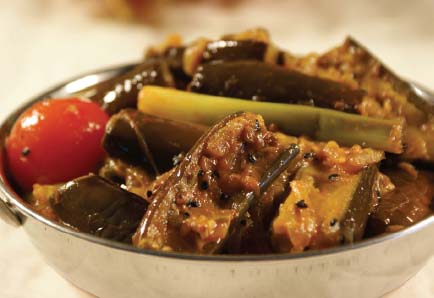
You can use whatever vegetables are in season for this dish. I have used eggplants cooked with onions. This delicious recipe is generous with the oil as eggplants soak it up, making them lovely and silky.

▪ Wash and wipe the eggplants. Slice in half and cut each half into 2 slices.
▪ Heat the oil in a karahi or large, heavy-based frying pan and add the garlic, ginger and chilies. Fry for a minute.
▪ Add the eggplant and both types of onion to the pan and stir-fry on high heat until the vegetables begin to brown, about 5 minutes.
▪ Pull the vegetables towards the edges of the pan and let the oil pool in the middle. Place all the seeds into the hot oil and stir them around for a minute or two on medium heat, and then stir them into the vegetables.
▪ Sprinkle the turmeric, chili powder and salt on top, and cook for a minute longer before stirring in the curry sauce.
▪ Bring to a boil, turn down the heat and simmer for about 5 minutes, stirring now and then. Add the tomatoes if you are using them and simmer for another 5 minutes. Stir through the garam masala and cook for a minute more.
▪ Meanwhile, heat karahi dishes for about a minute on medium to high heat. Carefully transfer the curry to the hot karahis and serve sizzling.
Traditionally, the bone is left in providing extra flavor and richness to the sauce, but chicken fillets can be used instead. You can also use the chicken prepared as for chicken curries (page 59) to speed up the preparation, but, if you have time, it is worth trying this dish the traditional way.
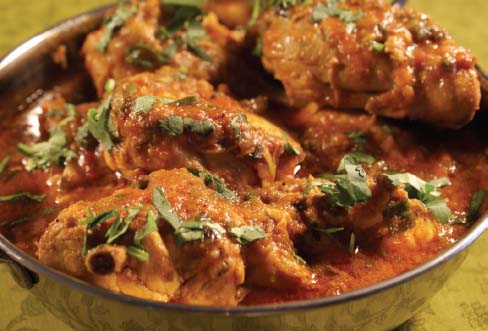
▪ Have a butcher skin the chicken, separate the wings and drumsticks and chop the rest of the chicken into 8 pieces. Rinse the chicken portions well and drain.
▪ Heat the oil in a large, heavy-based saucepan and add the onion. Stir around for a minute or two and add the garlic, ginger and chilies. Stir-fry for 2 or 3 minutes until aromatic.
▪ Add the chicken and stir to coat in the oil, then add the salt and tomatoes. Stir-fry until sizzling. Stir in 2 tablespoons of water.
▪ Turn down the heat and simmer, covered, for about 30 minutes (10–15 minutes if you are using sliced chicken fillets), stirring occasionally until the chicken is just cooked through and most of the liquid has evaporated.
▪ Use immediately or cool and refrigerate or freeze for later use.
▪ Heat the oil in a large, heavy-based frying pan or saucepan, and add the turmeric, half the garam masala and the chili powder. Cook, while stirring, for a minute or so until aromatic.
▪ Add the cooked chicken and juices and stir to coat in the spices. Once it is bubbling, turn down the heat and simmer, covered, for about 10 minutes, stirring frequently to allow the chicken to absorb the flavors. There should be very little liquid at this stage so that everything is gently frying in the oil.
▪ Add the curry sauce and bring back to a boil. Turn down the heat and simmer for another 8–10 minutes until the sauce is thick and the oil has separated from the sauce. Stir in the remaining garam masala and half the cilantro.
▪ Meanwhile, heat karahi dishes for about a minute on medium heat, carefully pour in the curry, sprinkle with the remaining cilantro and serve.
Similar to Keema Peas but spicier, this is a delicious dish eaten with chapatis, spiced yogurt and pickles (achar).
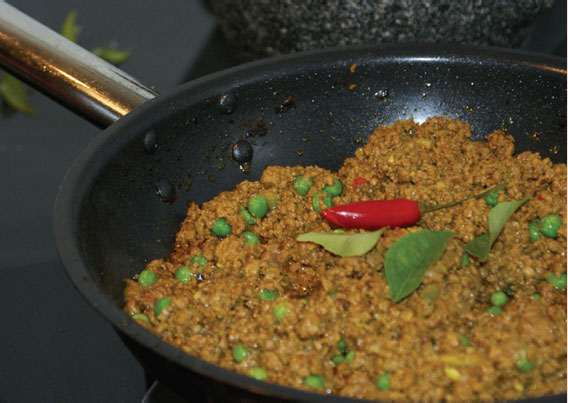
▪ Heat the oil in a large, heavy-based saucepan, and add the onions. Stir around for 2 or 3 minutes over high heat and add the meat.
▪ Stir-fry the meat and onions over high heat, breaking up any lumps, until the meat changes color, about 3 or 4 minutes. Turn down the heat, stir in the salt, turmeric and tomatoes.
▪ Bring to a boil and turn down the heat. Simmer, uncovered, over low heat for about 30–35 minutes, stirring now and then, until all the liquid has evaporated.
▪ Use immediately or cool and refrigerate or freeze for later use.
▪ Heat the oil in a large, heavy-based frying pan and add the curry leaves (if you are using them), and fry for a few seconds.
▪ Add the garlic, ginger, chilies and cumin, and stir-fry for a couple of minutes until aromatic. Stir in the paprika and chili powder.
▪ Add the meat to the pan and stir-fry until sizzling. Stir in the curry sauce and bring to a boil. Add the peas and bring to a boil again.
▪ Turn down the heat and simmer for 10–15 minutes until quite dry. Stir in the garam masala and cook for a minute to allow the meat to absorb the spices.
▪ Meanwhile heat karahi dishes for a minute on medium to high heat and carefully ladle in the meat. Serve.
Shoulder of lamb is superb for this recipe because it lends itself to long, slow cooking after which the meat is deliciously spiced and tender and almost falling off the bone. You can use leg of lamb cut into 2-inch (5 cm) chunks if you prefer.
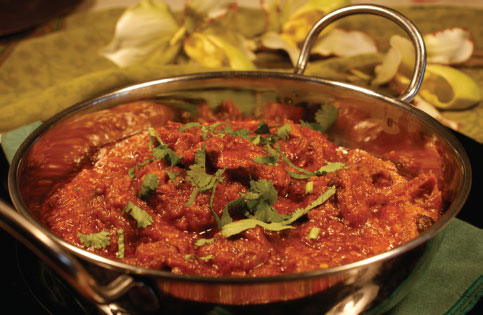
▪ Rinse the meat, drain well and pat dry with paper towels (wet meat will not brown).
▪ Heat the oil in a large, heavy-based saucepan and add the onions. Stir around for a minute or two on high heat and add the lamb pieces. Stir around in the hot oil until the meat colors, about 5 minutes.
▪ Add the garlic, ginger and chilies to the meat, stir-fry for a minute or two and add the salt. Stir and turn down the heat. Cook covered, stirring occasionally, for 1 hour.
▪ Stir in the tomatoes and cook for another 45 minutes to an hour until the meat is tender and a rich, dark brown.
▪ Skim off any excess fat and either use immediately, or cool and refrigerate or freeze for later use.
▪ Heat the oil in a large, heavy-based frying pan or saucepan, and add the cumin, turmeric, half the garam masala, chili powder and tomato paste.
▪ Cook, stirring, for a few seconds, then add the cooked meat and juices and stir to coat in the spices.
▪ Once it is bubbling, turn down the heat and simmer, covered, for about 10 minutes, stirring now and then to allow the meat to absorb the flavors. There should be very little liquid so that everything is gently frying in an oily masala. Sprinkle on the fenugreek leaves.
▪ Add the curry sauce and bring back to a boil. Turn down the heat and simmer for 8–10 minutes until the sauce is thick and the oil begins to separate from it.
▪ Stir in the remaining garam masala and half the cilantro.
▪ Meanwhile, heat karahi dishes for about a minute on medium to high heat, carefully pour in the curry, sprinkle with the remaining cilantro and serve.
For something so simple, this is quite a sumptuous dish — thick, creamy and satisfying. You can use 100 percent urad dhal or a mix of dhals (pulses) as I have. Traditionally made with generous amounts of ghee and homemade butter (makhan), this recipe uses olive oil and a little cream.
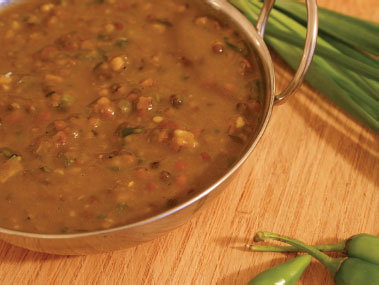
▪ Mix all three dhals in a bowl and wash well. Drain and place the dhals in a large, heavy-based saucepan and add the water.
▪ Bring to a boil, turn down the heat and cover the pan. Simmer gently for about 2 hours, stirring now and then, until the mixture is thick and creamy, adding a little more water if required. Or bring the pressure cooker to maximum pressure and cook for about 25 minutes.
Note: The dhal can be cooled and refrigerated at this stage for later use. It will keep well in the fridge for up to 3 days.
▪ Meanwhile, heat the oil in a frying pan or small saucepan and fry the onion until beginning to brown at the edges.
▪ Add the garlic, ginger and chilies and fry for a couple of minutes until aromatic. Stir in the fenugreek leaves if you are using them.
▪ Add the onion mixture, salt, garam masala and cilantro to the dhal and mix well. Simmer for a minute.
▪ Stir in the cream and serve.
This is a delicious chicken curry with robust flavors. It is typical of the flavors of eastern India. For those who have savored its delicious taste, it invokes memories such as this, as shared on the Indian cuisine blog, Hesel Ghor.
Remember those hurried meals put together at the end of a hard day’s travel at dimly lit circuit houses or government dak-bungalows. Thrown together by the chowkidar-caretaker-cook, the taste still lingers on. Probably the wonder of childhood, when things were so much more mysterious and the whole world was waiting to be discovered was the magic of the dish.
▪ Rinse the chicken fillets and pat dry with paper towels. Trim off fat and sinew and slice each fillet into 1-inch (2.5 cm) chunks.
▪ Heat the oil in a large, deep frying pan, add the cinnamon, peppercorns, cardamoms, cloves, mustard seeds, coriander and cumin, and stir-fry for a few seconds until the seeds start to pop.
▪ Add the garlic and ginger, and fry for about a minute until aromatic. Stir in the turmeric, tomato paste and vinegar.
▪ Add the chicken pieces and mix well to coat with the spices. Stir-fry the chicken on medium-high heat for about 5 minutes.
▪ Add the curry sauce, salt and chili powder, and bring to a boil. Turn down the heat and simmer for about 15–20 minutes until the chicken is tender and the sauce is thick.
▪ Stir in the chopped cilantro and serve.
This is a beautiful, full-flavored dish with big, tender pieces of chicken on the bone and lots of lovely sauce. Traditionally it was made with older, tougher birds that required long, slow cooking, which enhanced the flavor as well as tenderizing the meat. I recommend using good-quality free-range chicken and fresh herbs to experience the best of this dish.
▪ Heat the oil in a large, heavy-based saucepan and add the spring onions and garlic tops, if you are using them. Stir-fry on medium heat for 4–5 minutes. Add the fenugreek leaves and continue to stir-fry for 5 minutes.
▪ Add the garlic, ginger and chilies. Stir-fry on medium heat for 2 or 3 minutes and add the turmeric, half the garam masala and the chili powder. Cook, while stirring, for a minute or so until aromatic.
▪ Add the cooked chicken, including the juices, and stir to coat in the spices. Once it is bubbling, turn down the heat and simmer, covered, for about 10 minutes, stirring frequently to allow the chicken to absorb the flavors.
▪ Meanwhile, boil the potatoes in salted water for 8–10 minutes until just tender. Drain.
▪ Add the curry sauce to the chicken and bring back to a boil. Stir in the cooked potato, turn down the heat and simmer for another 8–10 minutes, stirring now and then, until the sauce is thick and the oil has separated from the sauce.
▪ Add the water and simmer for 2 minutes. Stir in the remaining garam masala and the cilantro, and serve.
Paneer, lamb, chicken and potato dishes made with pureed spinach (saag) are popular in Indian restaurants, but saag is rarely if ever served on its own. The tinned, pureed spinach used in restaurants is convenient and quite good when incorporated into other flavorful ingredients, but it does not compare with the saag made with fresh, leafy greens that is cooked in Indian households and eaten as a dish in its own right with cornmeal chapatis (rotis), yogurt and pickles. Meat and vegetarian dishes made with this saag are superb.
It is time consuming to make but you can cook a large batch and freeze it in serving-size portions that will be ready to use whenever you wish. You will need a large saucepan for this.
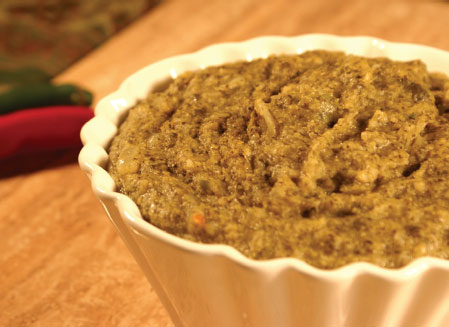
▪ Wash the greens and spinach two or three times in plenty of cold water to remove all grit and soil, then drain. Remove any tough stalks from the spinach. Remove the outer leaves of the brussels sprouts and rinse well. Rinse the broccoli.
▪ Shred the greens and spinach, roughly chop the sprouts and broccoli, or process in a food processor until roughly chopped, and place in a saucepan.
▪ Add the water and salt, and bring to a boil. If you are using a pressure cooker, cook on maximum pressure for 45 minutes. Otherwise simmer, uncovered, for about 30 minutes (it has a tendency to boil over if covered in the early stages), stirring now and then.
▪ Once the mixture has settled down, cover the saucepan and simmer for 2 hours 30 minutes. Stir every half hour or so and add a little more water if the mixture dries out.
▪ There should only be enough water left at the end of the cooking to make the mixture into a thickish puree.
▪ Keeping the saucepan on the heat, stir in the garlic, ginger and chilies followed by the polenta and continue to cook for 4–5 minutes. Turn off the heat.
▪ The mixture now needs to be turned into a coarse puree. As the greens will be very soft, it is possible to puree them by stirring vigorously with a large wooden spoon. If you have a hand blender, it is even easier. Insert the blender into the mixture and switch on briefly. Move the blender around in the pan until all the mixture is pureed. Don’t worry if it is a little runny, as the saag will thicken on cooling.
▪ Cool the saag, divide into portions and freeze if desired.
Note: If you can’t buy spring greens, mustard greens or purple sprouting broccoli, increase the quantities of the other ingredients or try Swiss chard, kale or cabbage.
Dhaba is the Indian word for a Punjabi family restaurant. The Dhaba curry is the basic traditional nonvegetarian curry of north India and is usually made with goat meat. It includes diced meat simmered until meltingly tender along with pieces of bone. Diners can be seen enthusiastically sucking on the bones at these Dhabas. I have provided the traditional recipe which requires some lamb pieces with bone left in, but you can use meat cooked as for lamb curries (page 71) along with some lamb or beef stock if you want to save time.
▪ Heat half the oil in a large, heavy-based saucepan and add half the meat. Stir-fry until brown. Remove and repeat with the remainder of the meat.
▪ Return the browned meat to the pan and add the onions. Stir-fry on high heat for about 5 minutes. Turn down the heat, mix in the salt and add the tomatoes. Bring to a boil, cover the pan and simmer on low heat for about 1 hour and 15 minutes or until the meat is tender and the onions have dissolved.
▪ Use immediately, or cool and refrigerate or freeze for later use.
▪ Heat the oil in a large, heavy-based saucepan and add the garlic, ginger and chilies. Stir-fry for a minute and add the remaining spices (except for the paprika and garam masala), mix well and stir-fry for a minute.
▪ Add the cooked meat and juices and stir well to coat with spices. Stir-fry on medium to high heat for about 5 minutes. Cover and allow the meat to simmer in the spices for 5-6 minutes on very low heat.
▪ Add the paprika and the curry sauce and bring to a boil. Simmer, uncovered, for 10 minutes. Stir in the garam masala and serve.
It may be hard to imagine a curry made from yogurt, but this is in fact quite a substantial (and incredibly tasty) dish popular throughout India. In more recent times it has been making an appearance in Indian restaurants, though generally as a “sauce” with chicken, fish or vegetables. Try it with rice or chapatis; it is quite delicious and simple to make.
If you can, leave the yogurt out of the fridge overnight to sour slightly. You won’t need to use any lemon juice if you do that.
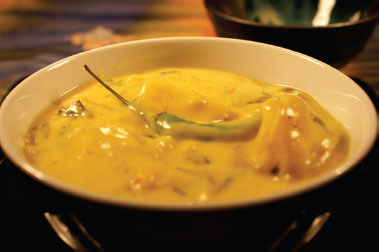
▪ In a large bowl, whisk together the yogurt, chickpea flour, salt and water.
▪ Heat the oil in a large, heavy-based saucepan, and add the fenugreek seeds, peppercorns, cumin seeds and curry leaves if you are using them. Fry for a few seconds until the seeds start to pop.
▪ Add the onion, spring onions and garlic tops if you are using them, and fry on medium heat for 3 minutes. Stir in the garlic, ginger and chilies, and stir-fry for a couple of minutes.
▪ Stir in the turmeric and add the potato and whole chilies. Stir around for a minute and pour in the yogurt mixture. Bring to a boil and simmer over low heat for about 30–35 minutes, stirring frequently, until the potato is cooked through.
▪ Stir in the garam masala, cilantro and lemon juice if you are using it. Serve with rice or chapati (roti).
TIP
For a variation, add onion, spinach (palak) or vegetable pakoras (see tips, page 46) to the finished yogurt curry.
Strong and spicy flavors are the keynotes of this dish. It is traditionally made with mutton simmered long and slow, but this recipe uses precooked lamb, making it a quick and simple dish.
▪ Heat the oil in a large, heavy-based frying pan and stir in the chilies and all the spice seeds. Cook for a few seconds on high heat until the seeds start to pop, and add the turmeric and chili powder.
▪ Stir in the yogurt and continue to stir on high heat for a minute or two until the yogurt bubbles and reduces.
▪ Add the curry sauce and salt, bring to a boil and stir in the cooked lamb.
▪ Turn down the heat and simmer for 10–15 minutes until the sauce is thick and the oil has separated to the surface.
▪ Serve simmering hot with rice.
Fresh and spicy, this dish is a favorite in northern India. An excellent accompaniment to rich meat curries, yogurt and chapatis, it is simple to make and delicious served hot or cold. Make sure you use good-quality, fresh cabbage.
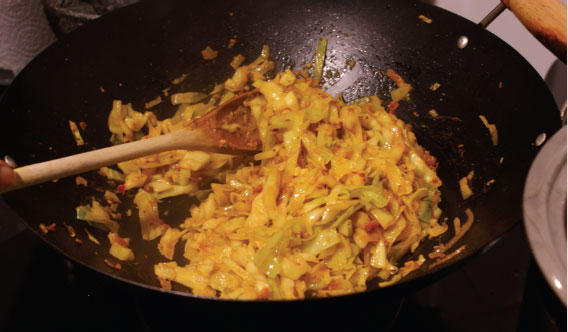
▪ Heat the oil in a large, heavy-based frying pan or wok and add the onion. Fry for a few minutes while stirring until the onion is transparent.
▪ Stir in the cumin seeds and fry for a minute. Add the garlic, ginger and chilies, and stir-fry for a minute or two until aromatic.
▪ Stir in the turmeric, followed by the cabbage. Stir-fry the cabbage on medium to high heat for 2 or 3 minutes and add in about 2 tablespoons of water and the salt.
▪ Turn down the heat a little and cook the cabbage for another 15 minutes, stirring frequently and adding a little more water if required to prevent it sticking to the bottom of the pan and burning.
▪ Stir in the garam masala and serve.
Shikari is the Indian word for hunter and this easy-to-cook dish from the Raj era is based on the cooking style of the shikaris when on a hunt. In its simplest form it is large pieces of fresh meat, rubbed with lime juice and hot spices, browned in ghee and simmered in salt and water until tender. The restaurant version includes some onion-based sauce and fresh herbs.
Cook this dish on a day when you have some time to putter around the kitchen because, although it is simple to make, the meat takes a bit of time to cook and it does not freeze well.
▪ Grind the whole spices to a fine powder in an electric grinder or with a pestle and mortar.
▪ Rinse the meat and drain well. Add the lime juice, 1 tablespoon of the oil and all the spices, and, using your hands, rub well into the meat. Allow to stand for about 10 minutes.
▪ Heat another tablespoon of oil in a large, heavy-based saucepan and add half the meat. Stir-fry on high heat until well browned. Remove from the pan and repeat with the remaining oil and meat.
▪ Return all the meat to the pan, add the water and salt and bring to a boil. Simmer, stirring occasionally, for about 2 hours until the meat is tender. Most of the liquid should have evaporated.
▪ Skim off excess fat, and use immediately or cool and refrigerate for up to 24 hours. For best results, do not freeze as the lovely spice flavors dull with freezing.
▪ Heat the oil in a large, heavy-based frying pan and stir in the curry sauce. Bring to a boil and add the meat and juices.
▪ Simmer gently for 15–20 minutes until the sauce is very thick. Stir in the cilantro and serve.